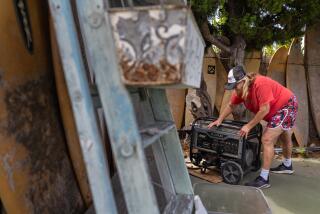$5-Million Lawsuit Filed as Cracks Plague 2nd Palmdale Subdivision
Seven Palmdale-area homeowners filed a $5-million lawsuit Friday, saying their two-year-old houses are cracking and sinking because of negligence and fraud by the builder in developing and selling the project.
The residents said the builder, Watt Industries, has refused their demands to trade their damaged houses for sound ones in Narcissa View Estates.
The homeowners plan to picket today at a builder-ordered auction of 24 unsold but apparently stable houses in their tract, saying they are outraged that they have not been given those residences instead.
The lawsuit was filed only two days after residents of another tract, Griffin Homes’ Santa Fe project, about five miles away in Palmdale, went public with similar complaints. At least 15 residences there were built on soil that is now expanding upward, cracking foundations and causing other damage, residents contend. The builder in that case repurchased six houses and is talking of buying 12 more.
In the Narcissa View Estates tract, at least 20 of the 125 houses were built on sinking soil that is up to 27 feet deep in some areas, said the homeowners’ attorney, Peter Anderson, who is also a geologist. Seven owners filed the lawsuit, but they said they believe the other 13 houses have also been damaged.
The lawsuit accuses Watt Industries--a Santa Monica-based developer that says it has built more than 100,000 residences--and several subsidiaries of knowing of the soil problem but failing to warn buyers. The suit also accuses Watt’s soils consultant, California Geo-Systems Inc. of Glendale, of gravely understating the soil problem before construction.
Geo-Systems pre-construction report said the unstable soil was only four feet deep, Anderson said.
Judi Leimert, general counsel for Watt Industries, and Richard Ramirez, president of California Geo-Systems, said they could not comment because they were unfamiliar with the lawsuit and unaware of problems at the tract.
In both projects, consultants have said the troublesome soils are characteristic of the high desert. The soils sink or expand in response to varying moisture content, such as runoff water from irrigation. Homeowners in both locations, however, blame the developers for not remedying the soil condition before building.
“We are very unhappy. This is your home. This is your major investment. This is where you want to raise your family. You get a little emotional about it,” said Janelle Giardine, whose Narcissa residence has a nearly inch-wide foundation crack running the length of the house.
Giardine and the other plaintiffs also complain of doors jammed open or closed, cracks in the interior and exterior walls and half-inch fissures in foundations extending more than six feet underground.
Anderson said the loose and sandy soil under their houses could sink as much as one to two feet below its level at the time of construction.
Anderson said the problem soil underlies the entire lots--of one-half acre to one acre--on which the houses are built.
The homeowners said Watt officials have proposed to remedy the problems by injecting a stabilizing mixture of concrete and soil deep into the ground under their houses, a process called mud-jacking. But owners are wary of the plan and of Watt’s demand that in return they absolve the company of future liability.
Anderson said the lawsuit was filed only after months of negotiations with Watt failed to produce an agreement under which the builder would buy the damaged houses or trade them for the unsold ones. The lawsuit seeks $300,000 for each of the seven owners plus a total of $3 million in punitive damages.
The damaged houses are at the northern end of the tract along Pearblossom Highway at 42nd and 43rd streets east. Anderson said a Watt subsidiary named Narcissa Corp., which he believes built the houses, and Watt Enterprises Chairman Ray Watt both are named defendants.
More to Read
Inside the business of entertainment
The Wide Shot brings you news, analysis and insights on everything from streaming wars to production — and what it all means for the future.
You may occasionally receive promotional content from the Los Angeles Times.










